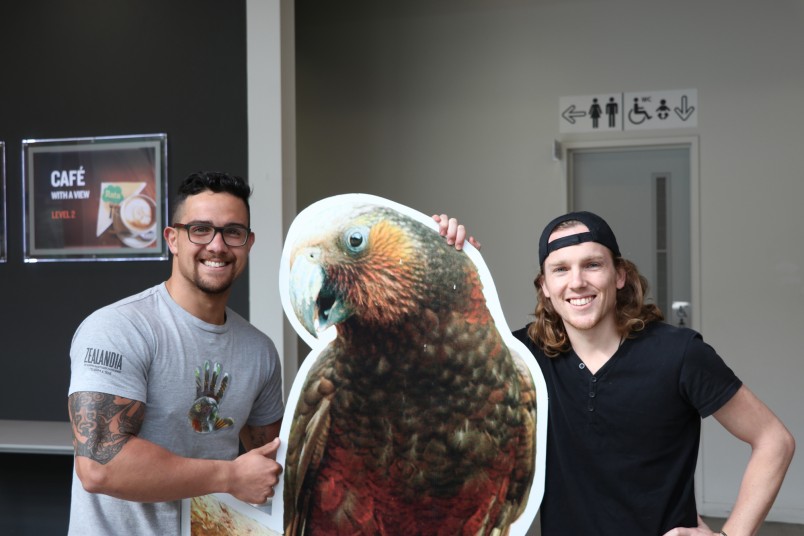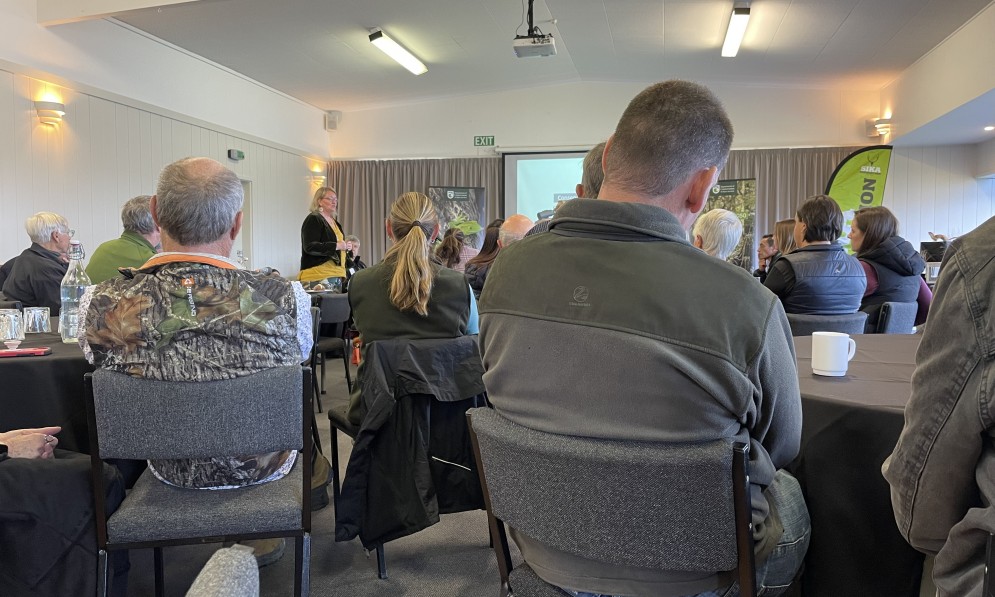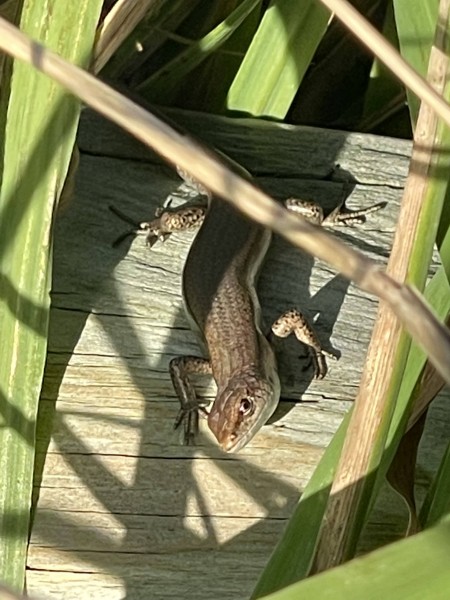Forest & Bird have eight regional conservation managers (RCMs) across Aotearoa New Zealand. Their role includes making submissions to regional and city council consultations, supporting local branch activities and building relationships with like-minded organisations.
Regional Conservation Manager: Darren van der Hoof (Ngāti Whare, Tūhoe)
Regions: Bay of Plenty, Hawkes Bay and Gisborne
Works: Monday to Friday
Special focuses: Pest management, on-the-ground mahi and general biodiversity
A teacher by profession, Darren’s first conservation job was at ZEALANDIA Te Mara a Tane as a conservation educator.

Darren with colleague Cam at ZEALANDIA promoting Kaka as Bird of the Year in 2016. Credit ZEALANDIA.
“I was drawn away from teaching to conservation roles by my passion for our environment,” he says. “Particularly our beautiful mokomoko lizards, skinks and geckos.”
From ZEALANDIA Darren worked at the Department of Conservation and then Rainbow Springs before joining the Forest & Bird team in 2021. One of his most enjoyable experiences so far has been meeting members from the eight Forest & Bird branches in his regions.
“A recent trip to Tairāwhiti really highlighted how super-knowledgeable the branch was – they were amazing hosts.”
Darren sees many opportunities for conservation success in the regions he covers. The rohe is big and has many challenges. Issues like water use are found everywhere, and if there is one change he’d like to see over the coming year, it would be some positive decisions, planning and action taken around water use by governing bodies.
“I think water in every region is precious. A win on this issue would go beyond a council declining some large water takes, and further degradation, and for all governing bodies to focus their planning and resources on educating on wise water use and promoting less water-intensive land use.”
These are some of the highlights from his diary:
13 June | Preparing my Matariki, Tupu-Ā-Rangi and Advocacy Science talk, in the office
Matariki is a significant time for Aotearoa. The link to teTaiao is strong and Forest & Bird and other organisations can reflect this in a variety of ways. The local Department of Conservation (DOC) community team in Tauranga hosted a Matariki event on 20 June for the local Tauranga community and asked if I would speak about the future of indigenous forests providing a major solution to climate change.
So, this week I worked to finalise this kōrero. Projects like this allow Forest & Bird to reach a wide audience, but also to form stronger relationships with our partners (like DOC). It allows us to communicate our key messages to a diverse community, and to educate and inform people. Often these opportunities - and the connections and relationships you build at these events - lead on to other benefits for Forest & Bird and te Taiao. The influence that Forest & Bird has at such kōrero or hui cannot be underestimated.
14 June | DOC Goat and Deer management hui, Taupo

Attending the Taupo DOC deer and goat hui was important for pest management in the region.
DOC’s hui about goat and deer had a wide spectrum of conservation stakeholders. Penny Nelson, Director-General DOC (and other crucial people) presented on the national budget for deer and goat management. Several local stakeholders including DOC, iwi, nearby councils, hunting organisations, environmental groups and our Forest & Bird branch members attended.
The $30 million the Department of Conservation was allocated for this project came about in part from the advocacy work by Forest & Bird.
The hui was held to discuss and share information on how the budget may be used. Being present at this hui meant I could get an understanding of DOC’s thinking and what suggestions Forest & Bird can raise through various channels to make sure that te Taiao is being taken care of.
The budget allocated for deer and goat management will have a significant impact on forests that are in collapse due to severe browsing. As more information about the management plan is available, I hope to be more involved in the regional aspects of this hugely important project to help make sure the money goes in the right places and the mahi is done the right way.
15 & 16 June | Logistical help for local community trapping projects, online
A lot of the mahi that RCMs do is around making submissions or influencing policy to have a positive outcome on te Taiao. But I also have a passion for the operational side of the job and enabling, improving, or helping to start more grassroots, on-the-ground projects is always a buzz for me.

Darren beside a possum caught in a trap line in the Otanewainuku Forest, Bay of Plenty. Image supplied.
This week I was looking at the operational aspect of two Bay of Plenty trapping projects - including purchasing traps and providing support to landowners on the required DOC documentation. Local branch members and iwi, as well as trusts, are usually involved in these conversations – which covers funding, ownership of the whenua and who will be doing the work on the ground.
Even though we met over Zoom, these connections with people doing the mahi on the ground keeps me focused - even digital hui have a positive impact on te Taiao. We got a step closer to getting sign-off from DOC, and talked with the trap providers, so traps for one of these community projects are likely to be in place by August.
At a local level this means more traps on the ground! Both these projects are working with local Māori to incorporate and upskill rangatahi at the same time as we work towards conserving te Taiao.
17 June | Bay of Plenty climate change risk assessment workshop, online
The Bay of Plenty regional council are currently looking at climate change risks and assessing them. This is the start of a journey to look at how we can be more resilient in the future. The process involves a range of different people and groups as we work on the vulnerabilities, consequences, and risks of climate change.
Previously we have met in person, but this workshop was held online. As we worked through the risks, it was exciting to see some progress on the ideas we'd put forward over the past year.
Representatives from Tauranga Moana Council, DOC, community groups and environmental groups were present, as well as Linda Conning (chair, Forest & Bird Eastern Bay of Plenty Branch) who has been providing valuable input. Māori are also working with the regional council to highlight the issues important to them.

Our warming climate is an issue as it increases pest plants and animals - like this plague skink - and pushes out our native taonga. Image supplied.
Climate impacts our entire environment - not just humans - and Forest & Bird’s presence at this workshop ensures the impact on te Taiao and some of our most vulnerable species is not overlooked.
The Bay of Plenty has a number of people, plants and animals living by the coast and climate change is already having an impact. Working together and sharing knowledge will be key to influencing how local councils and other organisations plan and operate as we move forward in a climate-impacted environment.
On a national level, other regional councils are following our mahi, so they can do something similar in their rohe.
Do you have what it takes to work at Forest & Bird!
If conservation is your passion, why not apply for a role with Forest & Bird?
All current vacancies are listed here
We welcome applications from people of all backgrounds and value diversity and inclusion, so if you find a role that excites you, send us your details!
This article first appeared in the June 2022 E-news.

